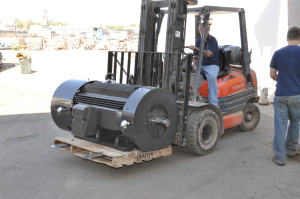Electric Motor Storing Procedures PART 2…
(see part 1)
Motor windings must be kept clean and dry to prevent insulation degradation while the motor is in storage. If the storage area is not climate controlled, heating should be used to prevent condensation inside the motor. The winding temperature must be kept above the dewpoint (this is usually accomplished by maintaining the winding temperature at 5-10°C (10-20°F) above ambient}. Space heaters should be energized if they are supplied (or added if the they are not supplied) while the motor is in storage. Another option is to supply low voltage DC to use the windings as a resistance heater. Single-phase AC voltage approximately 8-12% of rated voltage can be used instead of DC. A third alternative is to use a dehumidifier to lower the dewpoint of the room in which the motors are shared. Insulation resistance measurements of the winding(s) should be taken before the motor is put into storage. Even if it is to be idle for a very short period of time, at very least, test it before it is stored and just before it is put into service. That way, any decrease in the insulation resistance can be addressed before the motor is installed.
HINT: – attach a card to each motor ad record the insulation resistance, temperature, and date each time it is checked.
If the motor is in storage for an extended time, insulation resistance (IR) readings should be taken annually, and corrected to a standard temp. If the windings need to be cleaned and dried, take IR and PI readings again before putting the motor back into storage. According to IEEE 43: if the IR is greater than 5000 megohms, then the PI ration can be disregarded.
Carbon Brushes
DC machines, wound rotor motors, and some synchronous machines are fitted with carbon brushes. For long-term storage, the brushes should be lifted away from the commutator/slip rings to prevent a chemical reaction. The springs should be in the relaxed state, when practical, to avoid slow weakening of the springs.
 Placing Motor into Service
Placing Motor into Service
Once a motor is taken out of storage, there are a number of things to check before installing it. First, use a megohmmeter to measure the insulation resistance. Next inspect the motor and clean off any dust or dirt. Drain oil-filled motors before moving them to where they will be installed. After installing and aligning the motor, but before coupling it to the load, record vibration levels. For motors with rolling element bearings, evaluate the spectra for indications of bearing fault frequencies.
For large machines where shaft sag is a consideration, vibration analysis during start-up is a critical step in avoiding catastrophic damage. Be sure to document uncoupled baseline vibration levels. Following these guidelines, a motor that was in storage for any length of time is much more likely to perform as expected.
It seems obvious that a high cost machine justifies more precautions than a readily available, inexpensive machine. When storing an electric motor, be sure to consider the consequences of motor failure due to improper storage procedures. Even the smallest of motors could have enormous consequences if it fails during a critical part of the production process.
If you have an questions regarding motor storage procedures, or activating a previously stored motor, please contact us at Priest Electric. We’ll work closely with you to ensure best performance and longevity of your electric motors.
